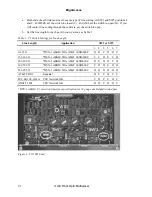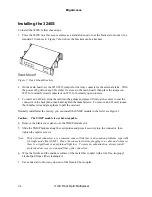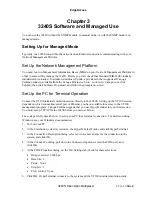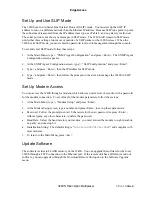
EdgeAccess
Caution:
To avoid damaging the fiber end-surface or connector, use extreme care when
installing or removing cables.
8. Plug in the optical cables with primary to primary, secondary to secondary, and Tx to Rx, Rx to
Tx orientation to avoid transmission errors.
9. Plug the straight-through serial cable into the COM port on your PC and the serial port on the
SNMP module. To connect to a local terminal, set the DTE/DCE switch to DTE. To connect to a
modem for remote use, set the DTE/DCE switch to DCE. For the connector pin assignments, see
Chapter 5.
10. At the ALM jack, plug in the cable to the device that will receive alarm information. Use a 3.5
mm phone plug, such as a Philmore 502P, with tip, ring, and sleeve to fit a Philmore 502K jack.
The tip and ring terminals of the jack carry the relay contacts.
11. Label each cable and connector with the signal name and direction.
12. Connect the power according to the type:
•
For 115 VAC, plug the power cord into a three-prong, grounded 115 VAC wall outlet.
•
For 230 VAC, use a power cord and plug that conforms to local regulations.
•
For DC power, connect the external -48 VDC power supply to the barrier strip connector on
the rear, at the positive (+) and negative (-) screw lugs.
13. Check the link loss for the fiber optic cables, then, if a transmitter is a high-power laser, set the
HI/LO Optical Power switch. In general, set the switch to LO for a link loss of less than 6 dB, or
to HI for a link loss of more than 6 dB.
Front and Rear Panel Functions and Power-Up
These system switches are located on the rear panel of the chassis:
•
MAST/SLV: For a point-to-point application, set this switch on both multiplexers to MAST. For
a master/slave ring application, set this switch on one unit to MAST and on all others to SLV.
•
MODE: For local loopback, set to LOC; for normal operation, set to NOR; for remote loopback,
set to REM; to control this through software, set to NOR
•
Redundant Optics (optional): For manual operation on the Primary link for maintenance or
resetting alarms, set to PRI; for manual operation on the Secondary link for maintenance or
resetting alarms, set to SEC; for normal operation and software management, set to AUTO
•
HI/LO (Primary and Secondary, high-power laser): Selects the power for the optical transmitters
The SNMP Management module includes these connectors:
•
9-Pin RS-232 Serial Port Supports RS-232 protocols. Use a straight-through cable with this port.
Chapter 3: The default parameters for this port are 9600 baud, No Parity, 8 bits, and one stop bit
(N, 8, 1) with VT100 terminal emulation.
•
10BASE-T Port Supports standard 10 MHz Ethernet. You must set up the SNMP Agent and
Host Table through the Console port before you can connect through Ethernet.
3240S Fiber-Optic Multiplexer
2-5
Summary of Contents for 3240S
Page 1: ...Model 3240S SNMP Managed T1 E1 Fiber Optic Multiplexer User Manual...
Page 2: ......
Page 4: ......
Page 6: ......
Page 12: ......
Page 20: ...EdgeAccess 2 8 3240S Fiber Optic Multiplexer...
Page 30: ......
Page 31: ......
Page 32: ......
Page 46: ......
Page 47: ......
Page 48: ......
Page 49: ......
















































